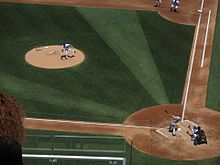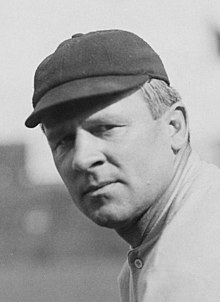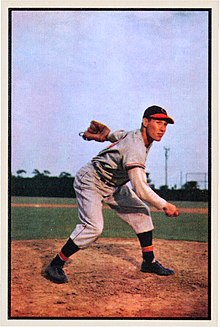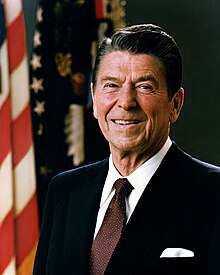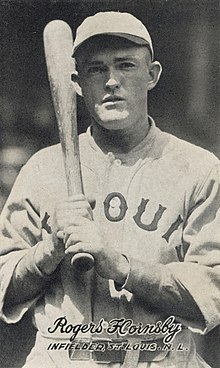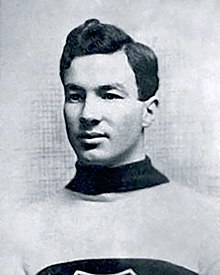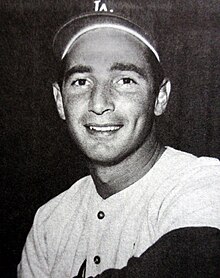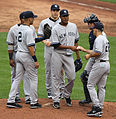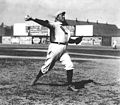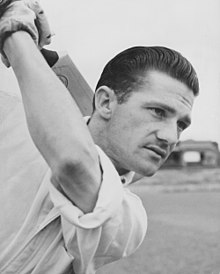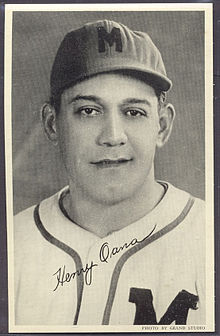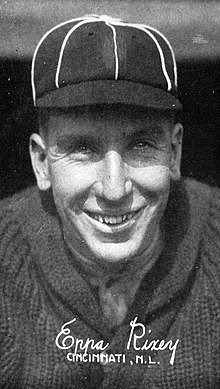Portal:Baseball
Portal maintenance status: (June 2018)
|
| Main page | Content, Categories & Topics | WikiProjects & Things you can do |
The Baseball Portal
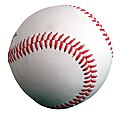
Baseball is a bat-and-ball sport played between two teams of nine players each, taking turns batting and fielding. The game occurs over the course of several plays, with each play generally beginning when a player on the fielding team, called the pitcher, throws a ball that a player on the batting team, called the batter, tries to hit with a bat. The objective of the offensive team (batting team) is to hit the ball into the field of play, away from the other team's players, allowing its players to run the bases, having them advance counter-clockwise around four bases to score what are called "runs". The objective of the defensive team (referred to as the fielding team) is to prevent batters from becoming runners, and to prevent runners advancing around the bases. A run is scored when a runner legally advances around the bases in order and touches home plate (the place where the player started as a batter).
The opposing teams switch back and forth between batting and fielding; the batting team's turn to bat is over once the fielding team records three outs. One turn batting for each team constitutes an inning. A game is usually composed of nine innings, and the team with the greater number of runs at the end of the game wins. Most games end after the ninth inning, but if scores are tied at that point, extra innings are usually played. Baseball has no game clock, though some competitions feature pace-of-play regulations such as the pitch clock to shorten game time.
Baseball evolved from older bat-and-ball games already being played in England by the mid-18th century. This game was brought by immigrants to North America, where the modern version developed. Baseball's American origins, as well as its reputation as a source of escapism during troubled points in American history such as the American Civil War and the Great Depression, have led the sport to receive the moniker of "America's Pastime"; since the late 19th century, it has been unofficially recognized as the national sport of the United States, though in modern times is considered less popular than other sports, such as American football. In addition to North America, baseball spread throughout the rest of the Americas and the Asia–Pacific in the 19th and 20th centuries, and is now considered the most popular sport in parts of Central and South America, the Caribbean, and East Asia, particularly in Japan, South Korea, and Taiwan. (Full article...)
 Featured articles - load new batch
Featured articles - load new batch
-
Image 1
John Joseph McGraw (April 7, 1873 – February 25, 1934) was an American Major League Baseball (MLB) player and manager who was for almost thirty years manager of the New York Giants. He was also the third baseman of the pennant-winning 1890s Baltimore Orioles teams, noted for their innovative, aggressive play.
McGraw was born into poverty in Truxton, New York. He found an escape from his hometown and a bad family situation through baseball, beginning a quick rise through the minor leagues that led him to the Orioles at the age of 18. Under the tutelage of manager Ned Hanlon, the Orioles of the 1890s won three National League (NL) pennants; McGraw was one of the stalwarts of the team alongside Wee Willie Keeler, Hughie Jennings, and Wilbert Robinson. The Orioles perfected the hit and run play and popularized the Baltimore chop; they also sought to win by intimidating the opposing team and the umpire. (Full article...) -
Image 2
George Herman "Babe" Ruth (February 6, 1895 – August 16, 1948) was an American professional baseball player whose career in Major League Baseball (MLB) spanned 22 seasons, from 1914 through 1935. Nicknamed "the Bambino" and "the Sultan of Swat", he began his MLB career as a star left-handed pitcher for the Boston Red Sox, but achieved his greatest fame as a slugging outfielder for the New York Yankees. Ruth is regarded as one of the greatest sports heroes in American culture and is considered by many to be the greatest baseball player of all time. In 1936, Ruth was elected to the Baseball Hall of Fame as one of its "first five" inaugural members.
At age seven, Ruth was sent to St. Mary's Industrial School for Boys, a reformatory where he was mentored by Brother Matthias Boutlier of the Xaverian Brothers, the school's disciplinarian and a capable baseball player. In 1914, Ruth was signed to play Minor League baseball for the Baltimore Orioles but was soon sold to the Red Sox. By 1916, he had built a reputation as an outstanding pitcher who sometimes hit long home runs, a feat unusual for any player in the dead-ball era. Although Ruth twice won 23 games in a season as a pitcher and was a member of three World Series championship teams with the Red Sox, he wanted to play every day and was allowed to convert to an outfielder. With regular playing time, he broke the MLB single-season home run record in 1919 with 29. (Full article...) -
Image 3Los Angeles Angels center fielder Mike Trout hits a home run on a pitch from New York Mets pitcher Tommy Milone on May 21, 2017.
Baseball is a bat-and-ball sport played between two teams of nine players each, taking turns batting and fielding. The game occurs over the course of several plays, with each play generally beginning when a player on the fielding team, called the pitcher, throws a ball that a player on the batting team, called the batter, tries to hit with a bat. The objective of the offensive team (batting team) is to hit the ball into the field of play, away from the other team's players, allowing its players to run the bases, having them advance counter-clockwise around four bases to score what are called "runs". The objective of the defensive team (referred to as the fielding team) is to prevent batters from becoming runners, and to prevent runners advancing around the bases. A run is scored when a runner legally advances around the bases in order and touches home plate (the place where the player started as a batter).
The initial objective of the batting team is to have a player reach first base safely; this generally occurs either when the batter hits the ball and reaches first base before an opponent retrieves the ball and touches the base, or when the pitcher persists in throwing the ball out of the batter's reach. Players on the batting team who reach first base without being called "out" can attempt to advance to subsequent bases as a runner, either immediately or during teammates' turns batting. The fielding team tries to prevent runs by using the ball to get batters or runners "out", which forces them out of the field of play. The pitcher can get the batter out by throwing three pitches which result in strikes, while fielders can get the batter out by catching a batted ball before it touches the ground, and can get a runner out by tagging them with the ball while the runner is not touching a base. (Full article...) -
Image 4
Jack Roosevelt Robinson (January 31, 1919 – October 24, 1972) was an American professional baseball player who became the first African-American to play in Major League Baseball (MLB) in the modern era. Robinson broke the color line when he started at first base for the Brooklyn Dodgers on April 15, 1947. The Dodgers signing Robinson heralded the end of racial segregation in professional baseball, which had relegated black players to the Negro leagues since the 1880s.
Born in Cairo, Georgia, Robinson was raised in Pasadena, California. A four-sport student athlete at Pasadena Junior College and the University of California, Los Angeles, he was better known for football than he was for baseball, becoming a star college player with the UCLA Bruins football team. Following his college career, Robinson was drafted for service during World War II but was court-martialed for refusing to sit at the back of a segregated Army bus, eventually being honorably discharged. Afterwards, he signed with the Kansas City Monarchs of the Negro leagues, where he caught the eye of Branch Rickey, general manager of the Brooklyn Dodgers, who thought he would be the perfect candidate for breaking the color line in MLB. (Full article...) -
Image 5
Robert William Andrew Feller (November 3, 1918 – December 15, 2010), nicknamed "the Heater from Van Meter", "Bullet Bob", and "Rapid Robert", was an American baseball pitcher who played 18 seasons in Major League Baseball (MLB) for the Cleveland Indians between 1936 and 1956. In a career spanning 570 games, Feller pitched 3,827 innings and posted a win–loss record of 266–162, with 279 complete games, 44 shutouts, and a 3.25 earned run average (ERA). His career 2,581 strikeouts were third all-time upon his retirement.
A prodigy who bypassed baseball's minor leagues, Feller made his debut with the Indians at the age of 17. His career was interrupted by four years of military service (1942–1945) as a United States Navy Chief Petty Officer aboard USS Alabama during World War II. Feller became the first pitcher to win 24 games in a season before the age of 21. He threw no-hitters in 1940, 1946, and 1951, and 12 one-hitters, both records at his retirement. He helped the Indians win a World Series title in 1948 and an American League-record 111 wins and the pennant in 1954. Feller led the American League in wins six times and in strikeouts seven times. In 1946 he recorded 348 strikeouts, the most since 1904 and then believed to be a record. (Full article...) -
Image 6
Ronald Wilson Reagan (February 6, 1911 – June 5, 2004) was an American politician and actor who served as the 40th president of the United States from 1981 to 1989. He was a member of the Republican Party and became an important figure in the American conservative movement. His presidency is known as the Reagan era.
Born in Illinois, Reagan graduated from Eureka College in 1932 and was hired the next year as a sports broadcaster in Iowa. In 1937, he moved to California where he became a well-known film actor. During his acting career, Reagan was president of the Screen Actors Guild twice, from 1947 to 1952 and from 1959 to 1960. In the 1950s, he hosted General Electric Theater and worked as a motivational speaker for General Electric. Reagan's "A Time for Choosing" speech during the 1964 presidential election launched his rise as a leading conservative figure. After being elected governor of California in 1966, he raised state taxes, turned the state budget deficit into a surplus and implemented harsh crackdowns on university protests. Following his loss to Gerald Ford in the 1976 Republican Party presidential primaries, Reagan won the Republican Party's nomination and then a landslide victory over President Jimmy Carter in the 1980 presidential election. (Full article...) -
Image 7
Herschel Greer Stadium was a Minor League Baseball park in Nashville, Tennessee, on the grounds of Fort Negley, an American Civil War fortification, approximately two mi (3.2 km) south of the city's downtown district. The facility closed at the end of the 2014 baseball season and remained deserted for over four years until its demolition in 2019. Following an archaeological survey, the land is expected to be reincorporated into Fort Negley Park.
Greer was opened in 1978 for the Nashville Sounds, an expansion franchise of the Double-A Southern League who moved to the Triple-A American Association in 1985 and to the Triple-A Pacific Coast League in 1998. The stadium played host to the team until 2014. The subject of numerous upgrades and repairs to maintain its functionality, Greer became one of the oldest stadiums used by a Triple-A team and had fallen well below professional baseball's standards for a stadium at that class level by the end of its use. For over a decade, the Sounds attempted to secure agreements with the Metropolitan Government of Nashville and Davidson County for a new ballpark to replace Greer, eventually resulting in the construction of First Tennessee Park, which became the Sounds' new home in 2015. (Full article...) -
Image 8

On July 10, 1932, the Philadelphia Athletics beat the Cleveland Indians 18–17 in 18 innings in a Major League Baseball game played at League Park in Cleveland. Several major-league records were set during the game; for example, Johnny Burnett of the Indians became the only player to hit safely nine (or even eight) times in a game, while Cleveland's 33 hits and the teams' combined 58 hits are also single-game records. Pitcher Eddie Rommel secured the win for the Athletics, pitching an American League-record 17 innings in relief after Philadelphia's Lew Krausse gave up three runs in the first inning. The 29 hits Rommel allowed are a major-league record; the 14 runs against him are the most given up by a winning pitcher.
Coming into the game, the Athletics, who were the three-time defending American League champions, trailed the New York Yankees in the standings by 71⁄2 games. Sunday baseball was still illegal in Philadelphia, forcing the Athletics to make one-game road trips on some Sundays, including July 10. With his pitching staff exhausted by six games in the previous three days, the owner and manager of the Athletics, Connie Mack, took only two pitchers on the train trip to Cleveland, giving the rest of the staff the day off. With no chance of being relieved except by a position player, Rommel pitched with mixed effectiveness, giving up six runs in the seventh inning but only two runs in the final nine innings of the game. He aided his own cause by getting three hits in seven at bats. Cleveland's Wes Ferrell took the loss after Jimmie Foxx got his sixth hit of the game and then scored. Foxx had already batted in eight runs, having hit three home runs and accumulated sixteen total bases, tying a record that has since been broken. (Full article...) -
Image 9
Morris Berg (March 2, 1902 – May 29, 1972) was an American professional baseball catcher and coach in Major League Baseball who later served as a spy for the Office of Strategic Services during World War II. He played 15 seasons in the major leagues, almost entirely for four American League teams, though he was never more than an average player and was better known for being "the brainiest guy in baseball." Casey Stengel once described Berg as "the strangest man ever to play baseball."
Berg was a graduate of Princeton University and Columbia Law School, spoke several languages, and regularly read ten newspapers a day. His reputation as an intellectual was fueled by his successful appearances as a contestant on the radio quiz show Information Please, in which he answered questions about the etymology of words and names from Greek and Latin, historical events in Europe and the Far East, and ongoing international conferences. (Full article...) -
Image 10
Rogers Hornsby (April 27, 1896 – January 5, 1963), nicknamed "the Rajah", was an American baseball infielder, manager, and coach who played 23 seasons in Major League Baseball (MLB). He played for the St. Louis Cardinals (1915–1926, 1933), New York Giants (1927), Boston Braves (1928), Chicago Cubs (1929–1932), and St. Louis Browns (1933–1937). He was named the National League (NL)'s Most Valuable Player (MVP) twice, and was a member of one World Series championship team.
Born in Winters, Texas, and raised in Fort Worth, Texas, Hornsby played for several semi-professional and minor league teams. In 1915, he began his major league career with the St. Louis Cardinals and remained with the team for 12 seasons. During this period, Hornsby won his first MVP Award and the Cardinals won the 1926 World Series. After that season, he spent one season with the New York Giants and another with the Boston Braves before being traded to the Chicago Cubs. He played with the Cubs for four years and won his second MVP Award before the team released him in 1932. Hornsby re-signed with the Cardinals in 1933, but was released partway through the season, effectively ending his career as a full-time player. He was picked up by the St. Louis Browns and remained there until his final season in 1937, though he made only 67 appearances for them as a player. From 1925 to 1937, Hornsby was intermittently a player-manager. After retiring as a player, he managed the Browns in 1952 and the Cincinnati Reds from 1952 to 1953. (Full article...) -
Image 11
Mariano Rivera (born November 29, 1969) is a Panamanian-American former professional baseball pitcher who played 19 seasons in Major League Baseball (MLB) for the New York Yankees, from 1995 to 2013. Nicknamed "Mo" and "Sandman", he spent most of his career as a relief pitcher and served as the Yankees' closer for 17 seasons. A thirteen-time All-Star and five-time World Series champion, he is MLB's career leader in saves (652) and games finished (952). Rivera won five American League (AL) Rolaids Relief Man Awards and three Delivery Man of the Year Awards, and he finished in the top three in voting for the AL Cy Young Award four times. In 2019, he was inducted into the Baseball Hall of Fame in his first year of eligibility, and is to date the only player ever to be elected unanimously by the Baseball Writers' Association of America (BBWAA).
Raised in the modest Panamanian fishing village of Puerto Caimito, Rivera was an amateur player until he was signed by the Yankees organization in 1990. He debuted in the major leagues in 1995 as a starting pitcher, before permanently converting to a relief pitcher late that year. After a breakthrough season in 1996 as a setup man, he became the Yankees' closer in 1997. In the following seasons, he established himself as one of baseball's top relievers, leading the major leagues in saves in 1999, 2001, and 2004. Rivera primarily threw a sharp-moving, mid-90s mile-per-hour cut fastball that frequently broke hitters' bats and earned a reputation as one of the league's toughest pitches to hit. With his presence at the end of games, signaled by his foreboding entrance song "Enter Sandman", Rivera was a key contributor to the Yankees' dynasty in the late 1990s and early 2000s that won four championships in five years. He was an accomplished postseason performer, winning the 1999 World Series Most Valuable Player (MVP) Award and the 2003 AL Championship Series MVP Award, while setting postseason records that included lowest earned run average (ERA) (0.70) and most saves (42). (Full article...) -
Image 12
James Francis Thorpe (Meskwaki: Wa-Tho-Huk, May 22 or 28, 1887 – March 28, 1953) was an American athlete and Olympic gold medalist. A citizen of the Sac and Fox Nation, Thorpe was the first Native American to win a gold medal for the United States in the Olympics. Considered one of the most versatile athletes of modern sports, he won two Olympic gold medals in the 1912 Summer Olympics (one in classic pentathlon and the other in decathlon). He also played football (collegiate and professional), professional baseball, and professional basketball.
He lost his Olympic titles after it was found he had been paid for playing two seasons of semi-professional baseball before competing in the Olympics, thus violating the contemporary amateurism rules. In 1983, 30 years after his death, the International Olympic Committee (IOC) restored his Olympic medals with replicas, after ruling that the decision to strip him of his medals fell outside of the required 30 days. Official IOC records still listed Thorpe as co-champion in decathlon and pentathlon until 2022, when it was decided to restore him as the sole champion in both events. (Full article...) -
Image 13Ross with the Montreal Wanderers, circa 1907–18
Arthur Howey Ross (January 13, 1885 – August 5, 1964) was a Canadian professional ice hockey player and executive from 1905 until 1954. Regarded as one of the best defenders of his era by his peers, he was one of the first to skate with the puck up the ice rather than pass it to a forward. He was on Stanley Cup championship teams twice in a playing career that lasted thirteen seasons; in January 1907 with the Kenora Thistles and 1908 with the Montreal Wanderers. Like other players of the time, Ross played for several different teams and leagues, and is noted for his time with the Wanderers while they were members of the National Hockey Association (NHA) and its successor, the National Hockey League (NHL). In 1911, he led one of the first organized player strikes over increased pay. When the Wanderers' home arena burned down in January 1918, the team ceased operations and Ross retired as a player.
After several years as an on-ice official, he was named head coach of the Hamilton Tigers for one season. When the Boston Bruins were formed in 1924, Ross was hired as the first coach and general manager of the team. He later coached the team on three separate occasions until 1945, and stayed as general manager until his retirement in 1954. Ross helped the Bruins finish first place in the league ten times and win the Stanley Cup three times; Ross personally coached the team to two of those victories. After being hired by the Bruins, Ross, along with his wife and two sons, moved to a suburb of Boston, and he became an American citizen in 1938. He died near Boston in 1964. (Full article...) -
Image 14
Sanford Koufax (/ˈkoʊfæks/; né Braun; born December 30, 1935), nicknamed "the Left Arm of God", is an American former baseball pitcher who played 12 seasons in Major League Baseball (MLB) for the Brooklyn/Los Angeles Dodgers from 1955 to 1966. Widely regarded as one of the greatest pitchers in baseball history, Koufax was the first three-time winner of the Cy Young Award, each time winning unanimously and the only pitcher to do so when a single award was given for both the leagues; he was also named the National League Most Valuable Player in 1963. Retiring at the age of 30 due to chronic pain in his pitching elbow, Koufax was elected to the Baseball Hall of Fame in his first year of eligibility in 1972 at the age of 36, the youngest player ever elected.
Born in Brooklyn, New York, Koufax was primarily a basketball player in his youth and had pitched in only a few games before signing with the Brooklyn Dodgers at age 19. Due to the bonus rule he signed under, Koufax never pitched in the minor leagues. His lack of pitching experience caused manager Walter Alston to distrust Koufax, who saw inconsistent playing time during his first six seasons. As a result, though he often showed flashes of brilliance, Koufax struggled early on. Frustrated with the way he was being managed by the Dodgers, he almost quit after the 1960 season. After making adjustments prior to the 1961 season, Koufax quickly rose to become the most dominant pitcher in the major leagues, as well as the first major sports star on the West Coast. He was an All-Star in each of his last six seasons, leading the National League (NL) in earned run average each of his last five years, in strikeouts four times, and in wins and shutouts three times each. He was the first pitcher in the live-ball era to post an earned run average below 2.00 in three different qualifying seasons, and the first in the modern era to record a 300-strikeout season three times. (Full article...) -
Image 15
A picture of a Wii Sports disc
Wii Sports is a 2006 sports simulation video game developed and published by Nintendo for the Wii video game console. The game was released in North America along with the Wii on November 19, 2006, and in Japan, Australia, and Europe the following month. It was included as a pack-in game with the console in all territories except Japan, making it the first sports game included with the launch of a Nintendo system since Mario's Tennis for the Virtual Boy in 1995. The game was later released on its own as part of the Nintendo Selects collection of games.
Wii Sports is a collection of five sports simulations designed to demonstrate the motion-sensing capabilities of the Wii Remote. The five sports included are tennis, baseball, bowling, golf, and boxing. Players use the Wii Remote to mimic actions performed in real-life sports, such as swinging a tennis racket or rolling a bowling ball. The rules for each game are simplified to make them more accessible to new players. The game also features training and fitness modes that monitor players' progress in the sports. (Full article...)
General images - load new batch
-
Image 2By the 1860s Civil War, baseball (bottom) had overtaken its fellow bat-and-ball sport cricket (top) in popularity within the United States. (from History of baseball)
-
Image 3A game from the Cantigas de Santa Maria, c. 1280, involving tossing a ball, hitting it with a stick and competing with others to catch it (from History of baseball)
-
Image 4The strike zone determines the result of most pitches, and varies in vertical length for each batter. (from Baseball)
-
Image 5Pick-off attempt on runner (in red) at first base (from Baseball rules)
-
Image 6A New York Yankees batter (Andruw Jones) and a Boston Red Sox catcher at Fenway Park (from Baseball)
-
Image 7Diagram indicating the standard layot of positions (from Baseball)
-
Image 8Diagram of a baseball field Diamond may refer to the square area defined by the four bases or to the entire playing field. The dimensions given are for professional and professional-style games. Children often play on smaller fields. (from Baseball)
-
Image 9Fenway Park, home of the Boston Red Sox. The Green Monster is visible beyond the playing field on the left. (from Baseball)
-
Image 10The American Tobacco Company's line of baseball cards featured shortstop Honus Wagner of the Pittsburgh Pirates from 1909 to 1911. In 2007, the card shown here sold for $2.8 million. (from Baseball)
-
Image 11The typical motion of a right-handed pitcher (from Baseball rules)
-
Image 12Pitchers are generally substituted during mound visits (team gatherings at the pitcher's mound). (from Baseball rules)
-
Image 132013 World Baseball Classic championship match between the Dominican Republic and Puerto Rico, March 20, 2013 (from Baseball)
-
Image 14Baserunners generally stand a short distance away from their base between pitches, preparing themselves to either go back or steal the next base. (from Baseball rules)
-
Image 15Alexander Cartwright, father of modern baseball (from History of baseball)
-
Image 17Jackie Robinson in 1945, with the era's Kansas City Royals, a barnstorming squad associated with the Negro American League's Kansas City Monarchs (from History of baseball)
-
Image 18A runner sliding into home plate and scoring. (from Baseball)
-
Image 19Baseball games sometimes end in a walk-off home run, with the batting team usually gathering at home plate to celebrate the scoring of the winning run(s). (from Baseball rules)
-
Image 20Sadaharu Oh managing the Japan national team in the 2006 World Baseball Classic. Playing for the Central League's Yomiuri Giants (1959–80), Oh set the professional world record for home runs with 868. (from History of baseball)
-
Image 21An Afghan girl playing baseball in August 2002 (from Baseball)
-
Image 22A batter follows through after swinging at a pitched ball. (from Baseball rules)
-
Image 23A well-worn baseball (from Baseball)
-
Image 24Cy Young—the holder of many major league career marks, including wins and innings pitched, as well as losses—in 1908. MLB's annual awards for the best pitcher in each league are named for Young. (from Baseball)
-
Image 26Two players on the baseball team of Tokyo, Japan's Waseda University in 1921 (from Baseball)
-
Image 28Sadaharu Oh managing the Japan national team in the 2006 World Baseball Classic. Playing for the Central League's Yomiuri Giants (1959–80), Oh set the professional world record for home runs. (from Baseball)
-
Image 29The NL champion New York Giants baseball team, 1913. Fred Merkle, sixth in line, had committed a baserunning gaffe in a crucial 1908 game that became famous as Merkle's Boner. (from History of baseball)
-
Image 30In May 2010, the Philadelphia Phillies' Roy Halladay pitched the 20th major league perfect game. That October, he pitched only the second no-hitter in MLB postseason history. (from History of baseball)
-
Image 31Cover of Official Base Ball Rules, 1921 edition, used by the American League and National League (from Baseball rules)
-
Image 35Pesäpallo, a Finnish variation of baseball, was invented by Lauri "Tahko" Pihkala in the 1920s, and after that, it has changed with the times and grown in popularity. Picture of Pesäpallo match in 1958 in Jyväskylä, Finland. (from Baseball)
-
Image 36Japanese-Americans spectating a World War II-era game while in an internment camp. America's ties to immigrants and to Japan have been deeply shaped by a shared baseball heritage. (from History of baseball)
-
Image 371906 World Series, infielders playing "in" for the expected bunt and the possible play at the plate with the bases loaded (from Baseball rules)
-
Image 38Jackie Robinson in 1945, with the era's Kansas City Royals, a barnstorming squad associated with the Negro American League's Kansas City Monarchs (from Baseball)
-
Image 40A pitcher handing off the ball after being taken out of the game during a mound meeting. (from Baseball)
-
Image 41A first baseman receives a pickoff throw, as the runner dives back to first base. (from Baseball)
-
Image 43The standard fielding positions (from Baseball rules)
-
Image 44Rickey Henderson—the major leagues' all-time leader in runs and stolen bases—stealing third base in a 1988 game (from Baseball)
-
Image 45The strike zone, which determines the outcome of most pitches, varies in vertical length depending on the batter's typical height while swinging. (from Baseball rules)
 Good articles - load new batch
Good articles - load new batch
-
Image 1
Michael Eugene Fontenot Jr. (/ˌfɑːntɛnoʊ/; born June 9, 1980) is an American former professional baseball infielder who played in Major League Baseball (MLB) for the Chicago Cubs, San Francisco Giants, and Philadelphia Phillies. He batted left-handed and threw right-handed. Fontenot was commonly used at second base, shortstop, or third base during his career. He won a World Series with the Giants in 2010.
Fontenot grew up in Louisiana. He attended Louisiana State University (LSU) and was a member of the LSU Tigers team that won the 2000 College World Series. After two years of college baseball, he was a first round draft pick of the Baltimore Orioles in 2002. Named the organization's Minor League Player of the Year in 2003, Fontenot never played in the major leagues for Baltimore, as he was included in a 2005 trade with the Cubs that sent Sammy Sosa to Baltimore. Fontenot debuted briefly with the Cubs in 2005, but it was not until 2007 that he reached the major leagues full time. He batted .305 while primarily used as a bench player in 2008 and began 2009 as the Cubs' starting second baseman. However, Fontenot lost the role after batting only .230 through August 7. He was traded to the Giants in 2010, becoming part of the team's first World Series victory since 1954. (Full article...) -
Image 2
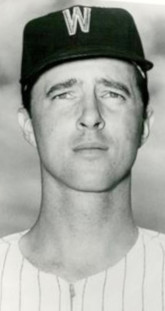
Peter Willits Burnside (July 2, 1930 – August 26, 2022) was an American professional baseball player and left-handed pitcher who appeared in 196 Major League Baseball games in 1955 and from 1957 to 1963 for the New York / San Francisco Giants, Detroit Tigers, Washington Senators and Baltimore Orioles. He was listed as 6 feet 2 inches (1.88 m) tall and 180 pounds (82 kg).
Burnside grew up in Evanston, Illinois, rooting for the Chicago Cubs. He signed with the New York Giants out of high school, under the agreement that he could earn his degree at Dartmouth College while pitching in their minor league system. After a stint in the United States Army, Burnside made his major league debut in 1955, picking up his first win the same year and impressing Carl Hubbell, Giants' Hall of Fame pitcher and farm director. Injuries prevented Burnside's return to the big leagues until 1957, and he only won one of the 16 games he pitched for the Giants in 1957 and 1958. Acquired by the Detroit Tigers for 1959, Burnside spent the whole season in their bullpen that year. Getting a chance to start with the team in 1960, he had a career-high seven wins before being selected by the Washington Senators in the expansion draft. (Full article...) -
Image 3
William (Billy) Ashley Sunday (November 19, 1862 – November 6, 1935) was an American evangelist and professional baseball outfielder. He played for eight seasons in the National League before becoming the most influential American preacher during the first two decades of the 20th century.
Born into poverty near Ames, Iowa, Sunday spent some years at the Iowa Soldiers' Orphans' Home before working at odd jobs and playing for local running and baseball teams. His speed and agility provided him the opportunity to play baseball in the major leagues for eight years. (Full article...) -
Image 4
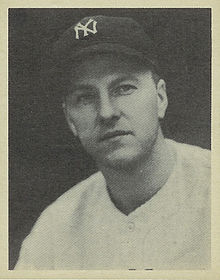
Montgomery Marcellus Pearson (September 2, 1908 – January 27, 1978) was an American baseball pitcher who played ten seasons in Major League Baseball (MLB). Nicknamed "Hoot", he played for the Cleveland Indians, New York Yankees and Cincinnati Reds from 1932 to 1941. He batted and threw right-handed and served primarily as a starting pitcher.
Pearson played minor league baseball for three different teams until 1932, when he signed with the Cleveland Indians. After spending four seasons with the organization, Pearson was traded to the New York Yankees, where he spent the next five years. At the conclusion of the 1940 season, he was traded to the Cincinnati Reds, with whom he played his last game on August 5, 1941. A four-time World Series champion, Pearson holds the MLB record for lowest walks plus hits per inning pitched (WHIP) in the postseason. He is noted for pitching the first no-hitter at the original Yankee Stadium. (Full article...) -
Image 5
Robert Neil Harvey (born 8 October 1928) is an Australian former cricketer who was a member of the Australian cricket team between 1948 and 1963, playing in 79 Test matches. He was the vice-captain of the team from 1957 until his retirement. An attacking left-handed batsman, sharp fielder and occasional off-spin bowler, Harvey was the senior batsman in the Australian team for much of the 1950s and was regarded by Wisden as the finest fielder of his era. Upon his retirement, Harvey was the second-most prolific Test run-scorer and century-maker for Australia.
One of six cricketing brothers, four of whom represented Victoria, Harvey followed his elder brother Merv into Test cricket and made his debut in January 1948, aged 19 and three months. In his second match, he became the youngest Australian to score a Test century, a record that still stands. Harvey was the youngest member of the 1948 Invincibles of Don Bradman to tour England, regarded as one of the finest teams in history. After initially struggling in English conditions, he made a century on his Ashes debut. Harvey started his career strongly, with six centuries in his first thirteen Test innings at an average over 100, including four in 1949–50 against South Africa, including a match-winning 151 not out on a sticky wicket. As Bradman's team broke up in the 1950s due to retirements, Harvey became Australia's senior batsman, and was named as one of the Wisden Cricketers of the Year in 1954, in recognition of his feat in scoring more than 2,000 runs during the 1953 tour of England. (Full article...) -
Image 6
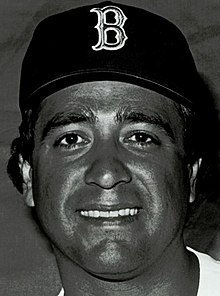
Michael Augustine Torrez (born August 28, 1946) is an American former Major League Baseball (MLB) starting pitcher. In an 18-season career, he pitched for the St. Louis Cardinals (1967–1971), Montreal Expos (1971–1974), Baltimore Orioles (1975), Oakland Athletics (1976–1977, 1984), New York Yankees (1977), Boston Red Sox (1978–1982), and New York Mets (1983–1984). As a member of the Yankees, he won two games of the 1977 World Series over the Los Angeles Dodgers. He batted and threw right-handed.
A native of Topeka, Kansas, Torrez was signed by the Cardinals in 1964. He made his MLB debut with them in 1967 and became a full-time major leaguer in 1969, winning nine of his final 10 starts that year. He had a 10–4 record in 1969 but an 8–10 record in 1970 before getting traded to the Expos during the 1971 season. After pitching one game for Montreal that year, Torrez spent the next three seasons with the ballclub, winning 16 games in 1972 and 15 games in 1974. Traded to the Orioles for 1975, he won 20 games for the only time in his career, posting a .690 winning percentage. The Orioles sent him to Oakland for 1976 as part of the Reggie Jackson trade; Torrez won 16 games for Oakland in 1976 before getting traded to the Yankees in April 1977. He reached the playoffs for the only time in his career that year, winning two World Series games as the Yankees defeated the Dodgers in six games. (Full article...) -
Image 7
Herbert Eugene Plews (June 14, 1928 – December 12, 2014) was an American Major League Baseball second baseman. He played four years in the majors, from 1956 to 1959 with the Washington Senators and in 1959 for the Boston Red Sox. In the minor leagues he played for Kansas City, Binghamton, Norfolk, and Denver before reaching the majors in 1956, and Toronto, Birmingham, Hawaii, Tacoma, and Arkansas after his major league career ended. During his playing career he served in the military from 1951 to 1952, during the Korean War. Plews batted left-handed and threw right-handed; he was listed as 5 feet 11 inches (1.80 m) tall and 160 pounds (73 kg).
Born in East Helena, Montana, Plews would be (at the time of his death) the only player from the Helena area to reach the major leagues. After four years at the University of Illinois at Urbana-Champaign, he signed with the New York Yankees in 1950. Plews's time in the minor leagues was interrupted by his military service, but he had made it to the Denver Bears (the top affiliate of the Yankees' system) by 1955. After the season, though, he was sent to the Senators in a multi-player trade. Plews debuted with Washington in 1956 and started at second base for them over much of the next three years. Mostly a part-time player in 1959, he was traded to the Red Sox in July, appearing in just 13 more games before being sent to the minors. He played six more years of professional baseball before retiring at the end of 1965. After his baseball career, Plews worked in cement plants, first in Montana and then in the Denver area. He died in 2014. (Full article...) -
Image 8
Eric Michael Surkamp (born July 16, 1987) is an American former Major League Baseball (MLB) pitcher who played for the San Francisco Giants, Chicago White Sox, Los Angeles Dodgers, and Oakland Athletics from 2011 to 2016. He also pitched for the Hanwha Eagles of the KBO League in 2016. Surkamp batted and threw left-handed with his fastball averaging 89 miles per hour (143 km/h).
Growing up, Surkamp helped Moeller High School become Ohio state baseball champions in 2004. He played college baseball at North Carolina State University (NC State) and was a member of Team USA in 2007. Drafted by the Giants in the sixth round in the 2008 MLB Draft, he was called up in August 2011 after posting a 2.02 earned run average (ERA), which led the Eastern League. He had a 2–2 record with the Giants and was considered a fringe candidate for the team's Opening Day roster in 2012, though he wound up missing that season due to Tommy John surgery. He made only one start for the Giants in 2013, allowing seven runs in 2+2⁄3 innings. in a 9–3 loss to the Cincinnati Reds. (Full article...) -
Image 9
Henry "Hank" Kawaihoa "Prince" Oana Jr. (January 22, 1910 – June 19, 1976) was a professional baseball player for 23 years from 1929 to 1951. He played portions of three seasons in Major League Baseball as an outfielder for the Philadelphia Phillies in 1934, and as a pinch hitter and pitcher for Detroit Tigers in 1943 and 1945. When Oana debuted with the Phillies, he became the fourth Hawaiian player to appear in the major leagues. He compiled a .308 batting average and a 3.77 earned run average (ERA) in three major league seasons.
Born in Hawaii, Oana played five sports in high school, and took up baseball professionally after he was noticed by Ty Cobb. He spent a few seasons in the minor leagues before joining the Phillies, who sent him back to the minors after six games in 1934. For the next decade, he played for various minor league teams, where his Hawaiian heritage proved to be both a selling point for teams and a hindrance to him making the majors, until the outbreak of World War II. Facing a shortage of active players, the Tigers signed him, and Oana played parts of 1943 and 1945 with the team. After 1945, he was sold to the Dallas Rebels, and he finished his professional career in 1951. He later operated a lakeside fishing business until his death in 1976. (Full article...) -
Image 10
Édgar Enrique Rentería Herazo (Spanish pronunciation: [ˈeðɣaɾ renteˈɾi.a]; born August 7, 1975), nicknamed "the Barranquilla Baby", is a Colombian former professional baseball shortstop. He threw and batted right-handed. He played for the Florida Marlins, St. Louis Cardinals, Boston Red Sox, Atlanta Braves, Detroit Tigers, San Francisco Giants, and Cincinnati Reds.
Born in Barranquilla, Colombia, Rentería was signed by the Florida Marlins in 1992. He debuted with them in 1996, and he finished second to Todd Hollandsworth in Rookie of the Year Award balloting. In 1997, his RBI single off Charles Nagy in the eleventh inning of Game 7 of the 1997 World Series won the first World Series in Marlins' history over the Cleveland Indians. In the 2010 World Series against the Texas Rangers, Rentería won the World Series Most Valuable Player Award with the San Francisco Giants after he hit game-winning home runs in Game 2 and Game 5. (Full article...) -
Image 11Bruce Eugene Kison (February 18, 1950 – June 2, 2018) was an American professional baseball pitcher, who played in Major League Baseball (MLB) for the Pittsburgh Pirates (1971–79), California Angels (1980–84) and Boston Red Sox (1985). Kison won two World Series championships with the Pirates, both over the Baltimore Orioles, and is perhaps best remembered for throwing 6+1⁄3 scoreless innings of relief to win Game 4 of the 1971 World Series. He batted and threw right-handed.
Kison grew up in Pasco, Washington, and was drafted by the Pirates in the 14th round of the 1968 Major League Baseball draft. He reached the major leagues in 1971 and relieved Luke Walker in the first inning of Game 4 of the World Series, throwing 6+1⁄3 scoreless innings as he enabled the Pirates to come from behind to win the game, and ultimately the Series. Bothered by a sore shoulder the next two years, Kison adjusted his delivery in the 1973–74 offseason, becoming a full-time starter by the middle of 1974. In 1976, he set career highs in wins (14) and earned run average (ERA) (3.08). He had a disappointing 1977 season, partly because of hangnail problems, and in 1978, he was moved back to the bullpen to start the year. He regained his rotation spot halfway through the season, though, and proved an important member of the Pirates' rotation once again in 1979, winning the season's final game to send the Pirates to the playoffs. He struggled in his only start of the World Series but won his second World Series ring as the Pirates defeated the Orioles again. (Full article...) -
Image 12

WTXF-TV (channel 29) is a television station in Philadelphia, Pennsylvania, United States. Owned and operated by the Fox network through its Fox Television Stations division, the station maintains studios on Market Street in Center City and a primary transmitter on the Roxborough tower farm, with a secondary transmitter on South Mountain in Allentown.
Channel 29 is the longest continuously operated Philadelphia UHF station, since May 16, 1965, as WIBF-TV from studios in the suburb of Jenkintown. WIBF-TV was owned by the Fox family alongside WIBF-FM 103.9. It was the first of three new commercial UHF outlets that year, broadcasting as an independent station focusing on community and sports programming. Taft Broadcasting purchased channel 29 in 1969 and renamed it WTAF-TV. Under Taft, the station slowly emerged as the leading independent station in the Philadelphia market with popular sports coverage, movies, and syndicated programs. The station was the broadcast outlet for the Philadelphia Flyers hockey team between 1971 and 1985 and for the Philadelphia Phillies baseball team from 1983 to 1992. The latter deal came after Taft Broadcasting purchased 47 percent of the team. In early 1986, WTAF-TV began producing a 10 p.m. local newscast. Later that year, it became affiliated with the new Fox television network. (Full article...) -
Image 13
Chauncey Edward Archiquette (November 17, 1877 – March 12, 1949) was an American athlete. A member of the Oneida people, he played several sports while attending Carlisle Indian Industrial School and then Haskell Institute. He later played for several barnstorming teams and coached at Haskell. While attending Haskell, Archiquette captained the football team and was the idol of a young Jim Thorpe, a Native American who went on to be considered one of the greatest athletes of all time. (Full article...) -
Image 14
Eppa Rixey Jr. (May 3, 1891 – February 28, 1963), nicknamed "Jephtha", was an American baseball player who played 21 seasons for the Philadelphia Phillies and Cincinnati Reds in Major League Baseball from 1912 to 1933 as a left-handed pitcher. Rixey was best known as the National League's leader in career victories for a left-hander with 266 wins until Warren Spahn surpassed his total in 1959.
Rixey attended the University of Virginia where he was a star pitcher. He was discovered by umpire Cy Rigler, who convinced him to sign directly with the Phillies, bypassing minor league baseball entirely. His time with the Phillies was marked by inconsistency. He won 22 games in 1916, but also led the league in losses twice. In 1915, the Phillies played in the World Series, and Rixey lost in his only appearance. After being traded to the Reds prior to the 1921 season, he won 20 or more games in a season three times, including a league-leading 25 in 1922, and posted eight consecutive winning seasons. His skills were declining by the 1929 season, when his record was 10–13 with a 4.16 earned run average. He pitched another four seasons before retiring after the 1933 season. (Full article...) -
Image 15

Since 1976, the New York Yankees of Major League Baseball (MLB) have maintained a strict appearance policy, specifying that players' hair must not touch their collars and that they may have mustaches but no other facial hair. The policy came from then-franchise owner George Steinbrenner, who believed that regulating his players' appearance would instill a sense of discipline. Steinbrenner began noting which players he believed needed haircuts when he took over the Yankees in 1973, but the policy was not codified until three years later. Steinbrenner's policy remains in place after his death, and has led to a number of dramatic appearance changes for players who come to the Yankees from other teams, such as Oscar Gamble, as well as pushback from players who prefer long hair and beards. In 1991, Don Mattingly was taken out of the Yankees' lineup for a day when he refused to cut his hair.
Most teams did not formally adopt any grooming or personal appearance policies until the 1970s, as earlier social customs meant that players were generally clean-shaven. This changed in 1972, when members of the Oakland Athletics, led by Reggie Jackson, formed The Mustache Gang. After that point, individual managers began to tighten or relax their teams' grooming standards as they saw fit. Steinbrenner's policy was inspired by that of the Cincinnati Reds, who forbid their players from growing facial hair between 1967 and 1999, when Greg Vaughn petitioned Marge Schott to rescind the rule. Former Yankees Mattingly and Joe Girardi have twice attempted to institute a similar policy on the Florida/Miami Marlins, but restrictions on that team have since loosened. (Full article...)
Did you know (auto-generated) - load new batch

- ... that Tom Urbani was an original Dirtbag?
- ... that baseball player Nick Solak was named after the sports bar where his parents first met?
- ... that Zack Kelly received a $500 signing bonus, lost money in his first professional seasons, and was released by two organizations before he made his Major League Baseball debut?
- ... that Corky Palmer coached the Southern Miss Golden Eagles to their only College World Series appearance in 2009?
- ... that Margaret Donahue was the first female executive in Major League Baseball?
- ... that after he retired from professional baseball, Paul Hinrichs became a Lutheran minister?
- ... that labor lawyer Dick Moss argued the 1975 case which resulted in the establishment of free agency in Major League Baseball?
- ... that Chuck Eisenmann went from professionally pitching in baseball to owning and training the dogs that starred on the Canadian television series The Littlest Hobo?
Quotes
| I ain't an athlete, lady. I'm a ballplayer. |
 Featured lists - load new batch
Featured lists - load new batch
-
Image 1

John Lackey was the Angels' Opening Day starting pitcher in 2003 and 2007.
The Los Angeles Angels are a Major League Baseball (MLB) franchise based in Anaheim, California. They play in the American League West division. The franchise has also gone by the names "Los Angeles Angels", "California Angels" and "Anaheim Angels" at various points in its history. The first game of the new baseball season for a team is played on Opening Day, and being named the Opening Day starter is an honor, which is often given to the player who is expected to lead the pitching staff that season, though there are various strategic reasons why a team's best pitcher might not start on Opening Day. The Angels have used 25 different Opening Day starting pitchers in their 51 seasons. The 25 starters have a combined Opening Day record of 26 wins, 18 losses and 7 no decisions. No decisions are awarded to the starting pitcher if the game is won or lost after the starting pitcher has left the game. It can also result if a starting pitcher does not pitch five full innings, even if his team retains the lead and wins.
Jered Weaver has the most Opening Day starts for the Angels, with seven, and had 6 consecutive opening day starts from 2010 to 2015. He has a record of three wins and two losses, with one no decision in those starts that resulted in a win. Mike Witt has the second most starts, with five, with one win, three losses, and one no decision that resulted in a loss. Frank Tanana, Mark Langston and Chuck Finley have all made four Opening Day starts for the Angels. Hall of Famer Nolan Ryan, Bartolo Colón and Jered Weaver have each made three such starts for the Angels. (Full article...) -
Image 2The Washington Nationals are an American professional baseball franchise based in Washington, D.C. They are members of the National League (NL) East Division in Major League Baseball (MLB). The team began playing in 1969 as an expansion team in Montreal, Quebec, then known as the Montreal Expos. There have been 18 different managers in the franchise's history. The team has played its home games at the Nationals Park since 2008. The Nationals are owned by Ted Lerner, with Mike Rizzo as their general manager.
The Expos' first manager was Gene Mauch, who managed for six seasons. Felipe Alou is the franchise's all-time leader in regular season games managed (1,408) and regular season game wins (691). Jim Fanning is the only Expos manager to have gone into the post-season. Buck Rodgers and Alou are the only managers to have won the NL Manager of the Year Award with the Expos, in 1987 and 1994 respectively. Karl Kuehl, Jim Fanning, and Tom Runnells have all spent their entire MLB managing careers with the Expos/Nationals. After Manny Acta was fired during the 2009 season, Jim Riggleman, the bench coach, was named interim manager to replace him, and was promoted to the position full-time for the 2010 season. After Riggleman resigned during the 2011 season and John McLaren ran the team for three games as an interim manager, the team hired veteran manager Davey Johnson, who had previously served as an advisor to Rizzo. Johnson led the team to the 2012 National League East title and the franchise's first playoff berth since moving to Washington and was 2012's NL Manager of the Year, but the team did not advance past the 2012 National League Division Series. Johnson retired after the 2013 season. Matt Williams took over in 2014, leading the team to another National League East title that season, and was 2014 NL Manager of the Year, but the team did not advance past the 2014 NLDS, and Williams was fired after an unsuccessful second year in 2015. Dusty Baker managed the team in 2016 and 2017, leading Washington to consecutive National League East titles, but the team did not advance beyond the NLDS in either season and Baker's contract was not renewed after the 2017 season. The Nationals hired Dave Martinez in October 2017 to take the helm in 2018; along with leading the team to its first World Series championship, Martinez has the most victories as a manager since the team moved to Washington. (Full article...) -
Image 3
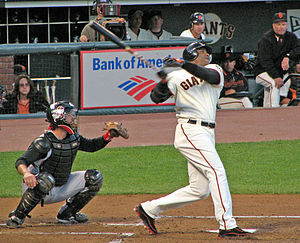
Barry Bonds, the all-time career home run leader in Major League Baseball, led the league in home runs twice including in 2001 when he set the record single-season mark
In baseball, a home run is scored when the ball is hit so far that the batter is able to circle all the bases ending at home plate, scoring himself plus any runners already on base, with no errors by the defensive team on the play. An automatic home run is achieved by hitting the ball on the fly over the outfield fence in fair territory. More rarely, an inside-the-park home run occurs when the hitter reaches home plate while the baseball remains in play on the field. In Major League Baseball (MLB), a player in each league[L] wins the home run title each season by hitting the most home runs that year. Only home runs hit in a particular league count towards that league's seasonal lead. Mark McGwire, for example, hit 58 home runs in 1997, more than any other player that year. However, McGwire was traded from the American League's (AL) Oakland Athletics to the National League's (NL) St. Louis Cardinals midway through the season and his individual AL and NL home run totals (34 and 24, respectively) did not qualify to lead either league.
The first home run champion in the National League was George Hall. In the league's inaugural 1876 season, Hall hit five home runs for the short-lived National League Philadelphia Athletics. In 1901, the American League was established and Hall of Fame second baseman Nap Lajoie led it with 14 home runs for the American League Philadelphia Athletics. Over the course of his 22-season career, Babe Ruth led the American League in home runs twelve times. Mike Schmidt and Ralph Kiner have the second and third most home run titles respectively, Schmidt with eight and Kiner with seven, all won in the National League. Kiner's seven consecutive titles from 1946 to 1952 are also the most consecutive home run titles by any player. (Full article...) -
Image 4

1891 Athletics manager Bill Sharsig
The Philadelphia Athletics were a professional baseball team that existed for two seasons from 1890 to 1891. Known alternatively as the Philadelphia Quakers, and sometimes informally as "Buffinton's Beauties", they played their first season in the newly created Players' League (PL) of 1890, and were managed by Jim Fogarty and Charlie Buffinton. After the demise of the PL following the 1890 season, the team joined the American Association (AA) for the 1891 season, and were managed by Bill Sharsig and George Wood. For each season, the franchise used Forepaugh Park as their home field.
Despite the existence of established major league representation in Philadelphia, the Phillies of the National League (NL) and the Athletics of the AA, the new PL franchise was able to sign veteran players, including Buffinton, Billy Shindle, George Wood, and Ben Sanders. The Quakers finished the season with a 68–63 win–loss record, with one tie, placing them fifth among the eight PL teams. (Full article...) -
Image 5

Cole Hamels, the Phillies' first-round pick in 2002
The Philadelphia Phillies are a Major League Baseball franchise based in Philadelphia, Pennsylvania. They play in the National League East division. Since the institution of Major League Baseball's Rule 4 Draft, the Phillies have selected 51 players in its first round. Officially known as the "First-Year Player Draft", the Rule 4 Draft is Major League Baseball's primary mechanism for assigning amateur baseball players from high schools, colleges, and other amateur baseball clubs to its teams. The draft order is determined based on the previous season's standings, with the team possessing the worst record receiving the first pick. In addition, teams which lost free agents in the previous off-season may be awarded compensatory or supplementary picks.
Of the 51 players picked in the first round by the Phillies, 26 have been pitchers, the most of any position; 20 of these were right-handed, while 6 were left-handed. Nine players picked in the initial round were outfielders, while six catchers, four first basemen, and four shortstops were selected. The team also selected one player each at second base and third base. Thirteen of the 45 players came from high schools or universities in the state of California, while Texas and Florida follow, with six and five players, respectively. (Full article...) -
Image 6There have been 20 managers in the history of the Seattle Mariners Major League Baseball (MLB) franchise. The Mariners franchise was formed in 1977 as a member of the American League. Darrell Johnson was hired as the first Mariners manager, serving for just over three seasons before being replaced during the 1980 season. In terms of tenure, Lou Piniella has managed more games and seasons than any other coach in their franchise history. He managed the Mariners to four playoff berths (1995, 1997, 2000 and 2001), led the team to the American League Championship Series in 1995, 2000 and 2001, and won the Manager of the Year award in 1995 and 2001. Until 2022, Piniella was the only manager in Mariners history to lead a team into the playoffs, with one of those times after a 116-win season, tying the record for most wins in a season. None of the previous managers had made it to the playoffs before. Piniella, however, managed the team in 34 playoff games, winning 15 and losing 19. Dick Williams is the only Mariners manager to have been inducted into the Baseball Hall of Fame.
There have been nine interim managers in Mariners history. In 1980, manager Darrell Johnson was replaced by Maury Wills. In 1981, manager Rene Lachemann replaced Maury Wills. In 1983, Lachemann was relieved by Del Crandall. Crandall did not last a full season either, as Chuck Cottier took over his job in 1984. By 1986, Cottier was replaced with a temporary manager, Marty Martinez. After one game, the Mariners found Dick Williams to take over the role of manager. He in turn was replaced by Jim Snyder in 1988. In 2007, manager Mike Hargrove resigned in a surprise move amidst a winning streak, citing increased difficulty in putting forth the same effort he demanded of his players. Hargrove was replaced with bench coach John McLaren midseason. A year later, in 2008, the Mariners front office decided McLaren was not performing by their standards, and was fired and replaced by interim manager Jim Riggleman. New general manager Jack Zduriencik hired Don Wakamatsu as skipper for the 2009 season; after finishing the season with a .525 winning percentage, the team's poor performance coupled with off-field issues led to Wakamatsu's firing on August 9, 2010. Daren Brown, who was the manager of the Mariners' Triple-A affiliate, the Tacoma Rainiers, managed the Mariners for the remainder of the 2010 season. Eric Wedge was hired to manage the team for the 2011 to 2013 seasons. Lloyd McClendon was hired as the Mariners' manager on November 7, 2013. (Full article...) -
Image 7

The New York Yankees are a Major League Baseball (MLB) franchise based in The Bronx, New York City, New York. They play in the American League East division. This list consists of the owners, general managers (GMs) and other executives of the Yankees. The GM controls player transactions, hires the manager and coaching staff, and negotiates with players and agents regarding contracts.
The longest-tenured general manager in team history is Brian Cashman, who serves in that role for 26 years and counting. The longest-tenured owner in team history is George Steinbrenner, who was the team's principal owner from 1973 until his death in 2010. (Full article...) -
Image 8

Jimmy Nelson won the PCL Pitcher of the Year Award and was selected for the Triple-A All-Star Game in 2014.
The Nashville Sounds Minor League Baseball team has played in Nashville, Tennessee, since being established in 1978 as an expansion team of the Double-A Southern League (SL). They moved up to Triple-A in 1985 as members of the American Association (AA) before joining the Pacific Coast League (PCL) in 1998. The team was placed in the Triple-A East in 2021 prior to this becoming the International League in 2022. In the history of the franchise, numerous teams, players, and personnel have won awards, been selected for All-Star teams, or led their league in various statistical areas.
Three Sounds have won league Most Valuable Player (MVP) awards: Steve Balboni, Brian Dayett, and Magglio Ordóñez. Twelve have won Pitcher of the Year awards: Bruce Berenyi, Geoff Combe, Andy McGaffigan, Jamie Werly, Stefan Wever, Chris Hammond, Scott Ruffcorn, R. A. Dickey, Johnny Hellweg, Jimmy Nelson, Robert Gasser, and Chad Patrick. Two have won Rookie of the Year awards: Jeff Abbott and Magglio Ordóñez. Five managers have won Manager of the Year awards: Stump Merrill, Rick Renick, Frank Kremblas, Steve Scarsone, and Rick Sweet. Ordóñez won the 1997 AA MVP Award as well as the Rookie of the Year Award, making him the only Nashville player to win two year-end league awards for the same season. The only other team personnel to win multiple league awards, though in separate seasons, are Renick, who won the AA Manager of the Year Award in 1993 and 1996, President Larry Schmittou, who won the SL Executive of the Year Award in 1978 and the AA Executive of the Year Award in 1987 and 1989, and radio broadcaster Bob Jamison, who was named the SL Broadcaster of the Year in 1980 and 1982. The franchise was recognized with the Minor League Baseball Organization of the Year Award in 2022. The team won the Larry MacPhail Award in 1978, 1980, and 1981. Two managers have won the Mike Coolbaugh Award: Mike Guerrero and Rick Sweet. Thirty Sounds have been selected by their Major League Baseball organization for player or pitcher of the year awards. (Full article...) -
Image 9

Camden Yards has been the Orioles' home ball park since 1992.
The Baltimore Orioles are a Major League Baseball (MLB) franchise based in Baltimore, Maryland. They play in the American League East division. The Orioles started playing in Baltimore in 1954, after moving from St. Louis, where they were known as the St. Louis Browns. The first game of the new baseball season for a team is played on Opening Day, and being named the Opening Day starter is an honor, which is often given to the player who is expected to lead the pitching staff that season, though there are various strategic reasons why a team's best pitcher might not start on Opening Day. The Orioles have used 33 different Opening Day starting pitchers in their 60 seasons since moving to Baltimore. The 33 starters have a combined Opening Day record of 22 wins, 18 losses and 17 no decisions. No decisions are only awarded to the starting pitcher if the game is won or lost after the starting pitcher has left the game.
The first Opening Day for the Orioles was played in Detroit against the Detroit Tigers on April 13, 1954. Don Larsen was the Orioles' Opening Day starting pitcher that day, in a game the Orioles lost 3–0. Jim Palmer and Mike Mussina have made the most Opening Day starts for the Baltimore Orioles, with six apiece. Palmer has a record of five wins and one loss in his Opening Day starts, and Mussina has a record of three wins, two losses and one no decision. Dave McNally made five Opening Day starts for the Orioles, with a record of three wins and no losses. Other Oriole pitchers who have made multiple Opening Day starts are Steve Barber, Rodrigo López, and Jeremy Guthrie, with three apiece, and Milt Pappas, Dennis Martínez, Mike Flanagan, Mike Boddicker, and Rick Sutcliffe, with two apiece. Flanagan's two Opening Day starts occurred eight years apart, in 1978 and 1986. (Full article...) -
Image 10
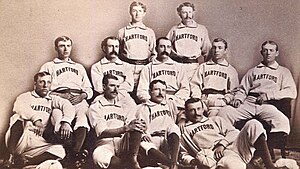
Members of the 1876 Hartford Dark Blues
The Hartford Dark Blues were a Major League Baseball club in the 1870s, based in Hartford, Connecticut, for three seasons and in Brooklyn, New York, for one. Hartford was a member of the National Association (NA), 1874–1875 and a founding member of the National League (NL) in 1876, when it played home games at the Hartford Ball Club Grounds. During 1877 the team played home games at the Union Grounds in Brooklyn and was sometimes called the Brooklyn Hartfords.
The team's owner, Morgan Bulkeley, who later became the first president of the NL in 1876, established the franchise in 1874; he gave the on-field captain duties to Lip Pike, who was also the starting center fielder. Among the other players signed by Hartford were pitcher Cherokee Fisher, who had led the NA in earned run average the two previous seasons, second baseman Bob Addy, and Scott Hastings. (Full article...) -
Image 11The Major League Baseball Comeback Player of the Year Award is presented by Major League Baseball (MLB) to the player who is judged to have "re-emerged on the baseball field during a given season." The award was developed in 2005, as part of a sponsorship agreement between MLB and Viagra. In 2005 and 2006 representatives from MLB and MLB.com selected six candidates each from the American (AL) and National Leagues (NL) and one winner for each league was selected via an online poll on MLB.com. Since then, the winners have been selected by a panel of MLB beat reporters. Under the current voting structure, first place votes are worth five points, second place votes worth three, and third place votes worth one with the award going to the player with the most points overall. Past winners have often overcome injury or personal problems en route to their award-winning season.
A Comeback Player of the Year Award has been given by The Sporting News since 1965 but its results are not officially recognized by Major League Baseball. Since the beginning of the MLB award in 2005, the recipients have been identical with the following exceptions: 2008 NL (TSN honored Fernando Tatís, MLB honored Brad Lidge), 2010 AL (TSN honored Vladimir Guerrero, MLB honored Francisco Liriano), 2012 AL (TSN honored Adam Dunn, MLB honored Fernando Rodney), 2016 (TSN honored Jose Fernandez and Mark Trumbo, MLB honored Anthony Rendon and Rick Porcello), 2018 NL (TSN honored Matt Kemp, MLB honored Jonny Venters), 2019 AL (TSN honored Hunter Pence, MLB honored Carlos Carrasco), and 2020 AL (TSN honored Carrasco, MLB honored Salvador Pérez). Liriano and Posey are the only players to win the MLB award multiple times with Liriano being the first to win it in each league. (Full article...) -
Image 12The Chicago Cubs are a professional baseball team based in Chicago, Illinois. The Cubs are members of the National League (NL) Central Division in Major League Baseball (MLB). In baseball, the head coach of a team is called the manager, or more formally, the field manager. The duties of the team manager include team strategy and leadership on and off the field. Since their inception as the White Stockings in 1876, the Cubs have employed 61 managers. The franchise's first manager was Baseball Hall of Famer Albert Spalding, who helped the White Stockings become the first champions of the newly formed National League.
After co-managing with Silver Flint during the 1879 Chicago White Stockings season, Hall of Famer Cap Anson began an 18-year managerial tenure in 1880, the longest in franchise history. Under Anson, the team won five more NL pennants — in 1880, 1881, 1882, 1885 and 1886—tying the 1885 World Series and losing the 1886 World Series in the process.[a] Anson won 1,283 games as the White Stockings' manager, the most in franchise history. After taking over for Hall of Fame manager Frank Selee in 1905, Frank Chance — another Hall of Famer — managed the team through the 1912 season. During his tenure, the franchise won four more NL pennants in 1906, 1907, 1908, and 1910, winning its only two World Series titles in 1907 and 1908 until 2016 Chance's .664 career winning percentage is the highest of any Cubs manager. After Chance, from 1913 through 1960, the Cubs employed nineteen managers, nine of which were inducted into the Hall of Fame. During this period, the Cubs won six more NL pennants, including three under manager Charlie Grimm. Split between Grimm's two managerial stints in the 1930s and 1940s, plus a brief appearance as manager in 1960, Grimm accumulated 946 career wins, second-most in franchise history behind Anson. (Full article...) -
Image 13Warren Spahn in 1953
The Warren Spahn Award is presented each season by the Oklahoma Sports Hall of Fame to the best left-handed pitcher in Major League Baseball (MLB). The award is named after Warren Spahn, who holds the MLB record in wins for a left-handed pitcher with 363. The Warren Spahn Award was created in 1999 by Richard Hendricks, the founder of the Territorial Capital Sports Museum, formerly Oklahoma Sports Museum, to honor Spahn, who resided in Oklahoma. The award was formerly presented at the Masonic Temple in Guthrie, Oklahoma until 2009, when the Oklahoma Sports Hall of Fame was granted ownership of the award, in partnership with the Bricktown Rotary Club. From 2009 to 2019, the award was presented at the annual Warren Spahn Award Gala, hosted by the Bricktown Rotary Club of Oklahoma City. Currently, the Oklahoma Sports Hall of Fame presents each annual award to the winner during season play at their respective team's ballpark.
The award has been won by 15 different pitchers. The winner is chosen based on rankings, which are based on wins, strikeouts, and earned run average. The most recent recipient is Chris Sale of the Atlanta Braves. Randy Johnson received the first four awards from 1999 through 2002. He attended the awards ceremony due to his respect for Spahn, who called him personally to ask him to attend. CC Sabathia (2007–2009), Johan Santana (2004, 2006), Clayton Kershaw (2011, 2013, 2014, 2017), and Blake Snell (2018, 2023) are also multiple Warren Spahn Award winners. Johnson (1999–2002), Santana (2004, 2006), Sabathia (2007) and Kershaw (2011, 2013, 2014), and Snell (2018, 2023) also won the Cy Young Award, given annually to the best pitcher in each league, in years they won the Warren Spahn Award.
Santana (2004, 2006), Sabathia (2007), Kershaw (2011, 2013, 2014), and Keuchel (2015) won the Pitcher of the Year Award, given annually to the most outstanding pitcher in each league, in years they won the Warren Spahn Award. (Full article...) -
Image 14
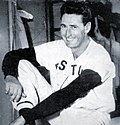
Ted Williams has the highest career on-base percentage in MLB history, led the American League in 12 seasons (also a record), and held the single-season on-base percentage record for 61 years.
In baseball statistics, on-base percentage (OBP) is a measure of how often a batter reaches base for any reason other than a fielding error, fielder's choice, dropped or uncaught third strike, fielder's obstruction, or catcher's interference. OBP is calculated in Major League Baseball (MLB) by dividing the sum of hits, walks, and times hit by a pitch by the sum of at-bats, walks, times hit by pitch and sacrifice flies. A hitter with a .400 on-base percentage is considered to be great and rare; only 61 players in MLB history with at least 3,000 career plate appearances (PA) have maintained such an OBP. Left fielder Ted Williams, who played 19 seasons for the Boston Red Sox, has the highest career on-base percentage, .4817, in MLB history. Williams led the American League (AL) in on-base percentage in twelve seasons, the most such seasons for any player in the major leagues. Barry Bonds led the National League (NL) in ten seasons, a NL record. Williams also posted the then-highest single-season on-base percentage of .5528 in 1941, a record that stood for 61 years until Bonds broke it with a .5817 OBP in 2002. Bonds broke his own record in 2004, setting the current single-season mark of .6094.
Players are eligible for the Hall of Fame if they have played at least 10 major league seasons, have been either retired for five seasons or deceased for six months, and have not been banned from MLB. These requirements leave 6 living players ineligible who have played in the past 5 seasons; 5 players (Bill Joyce, Ferris Fain, Jake Stenzel, Bill Lange, and George Selkirk) who did not play 10 seasons in MLB; and Shoeless Joe Jackson, who was banned for his role in the Black Sox Scandal.
Josh Gibson had a career obp of .458 but inexplicably isn’t on the list. (Full article...) -
Image 15On November 17, 1992, during the 1992–93 offseason, Major League Baseball (MLB) held an expansion draft in New York City to allow two expansion teams, the Florida Marlins and Colorado Rockies, to build their rosters prior to debuting in the National League's (NL) East and West divisions, respectively, in the 1993 MLB season.
The 1990 collective bargaining agreement between MLB owners and the MLB Players Association allowed the NL to expand by two members to match the American League (AL). In June 1991, MLB accepted bids of groups from Miami, Florida, and Denver, Colorado, with debuts set for 1993. (Full article...)
More did you know
- ... that baseball Hall of Famer Rogers Hornsby had his first plate appearance against King Lear?
- ... that the Philadelphia Phillies were the last of the original 16 Major League Baseball franchises to win the World Series?
- ... that Harry Blackmun's colleagues on the U.S. Supreme Court felt his long history of baseball in the Flood v. Kuhn majority opinion was beneath the Court's dignity?
- ... that the Danville 97s minor league baseball team name of 97s was selected as a tribute to the victims of the Wreck of the Old 97 train accident?
- ... that Frank Graham called Dave Bancroft "the greatest shortstop the Giants ever had and one of the greatest that ever lived"?
Sports portals
Selected picture

| Credit: Paul Thompson |
John Joseph McGraw (April 7, 1873–February 25, 1934), nicknamed "Little Napoleon" and "Muggsy", was a Major League Baseball player and manager. His total of 2840 victories as a manager ranks overall second behind only that of Connie Mack; he still holds the National League record with 2669 wins in that circuit.
Associated Wikimedia
The following Wikimedia Foundation sister projects provide more on this subject:
-
Commons
Free media repository -
Wikibooks
Free textbooks and manuals -
Wikidata
Free knowledge base -
Wikinews
Free-content news -
Wikiquote
Collection of quotations -
Wikisource
Free-content library -
Wikiversity
Free learning tools -
Wiktionary
Dictionary and thesaurus
More portals
- Pages with Spanish IPA
- Portals with triaged subpages from June 2018
- All portals with triaged subpages
- Portals with no named maintainer
- Automated article-slideshow portals with 51–100 articles in article list
- Automated article-slideshow portals with 501–1000 articles in article list
- Random portal component with 41–50 available subpages
- Automated article-slideshow portals with 201–500 articles in article list
- Random portal component with 11–15 available subpages
- Random portal component with 21–25 available image subpages

